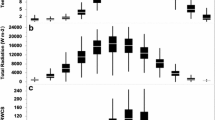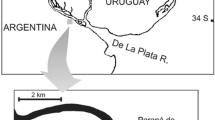Abstract
The composition of the phytoplankton of Lago Batata,a flood-plain lake connected to Rio Trombetas,undergoes a conspicuous annual cycle which is relatedto the hydrology (depth of water, rate of fluvialflushing) and the hydrography (stability, frequency ofmixing of the water) of the lake. From a sparsenanoplankton at high-water and high flushing, the lakepasses to desmid-diatom dominance and finally tofilamentous cyanobacteria when the lake is barely 2 mdeep. As it refills, the lake again becomes desmid-dominated; then, when the turbidity is least and thestratification most stable, Botryococcus becomesa major component. Eventually flushing becomes toorapid for any but the relatively fastest-growingspecies. These changes are gradual and, at the scaleof algal generation times, cannot be explained assharp or sudden disturbances. Neither do they have theproperties of ecological successions but ratherrepresent compositional responses to a progressiveenvironmental modification analogous to the floristicphenomenon of gradual climate change.
Similar content being viewed by others
References
Anagnostidis, K. & J. Komárek, 1988. Modern approach to the classification system of the Cyanophytes. 3–Oscillatoriales. Arch. Hydrobiol. (Suppl.) 80: 327–472.
Bozelli, R., 1994. Zooplankton community in relation to water-level fluctuations and inorganic turbidity in an Amazonian lake, Lagoa Batata, State of Pará, Brazil. Amazoniana 13: 17–32.
Brasil, 1976. Levantamento de recursos naturais. V. 10, Folha SA 21, Santarém. Ministériodas Minas e Energia, Rio de Janeiro, 522 pp.
Camargo, A. F. M. & R. K. Miyai, 1988. Caracterização limnológica do Lago Curuçá: lago de várzea do Rio Trombetas (águas claras), Pará. Acta Limnol. Brasil. 2: 153–180.
Connell, J. H., 1978. Diversity in tropical rain forests and coral reefs. Science 199: 1302–1310.
Edler, L., 1979. Recommendations for marine biological studies in the Baltic Sea; phytoplankton and chlorophyll. UNESCO (Working Group 11, Baltic Marine Biologists), Paris: 38 pp.
Esteves, F. A., S. M. Thomaz & F. Roland, 1994. Comparison of the metabolism of two floodplain lakes of the Trombetas River (Pará, Brazil) based on a study of diel variation. Amazoniana 13: 33–46.
García de Emiliani, M. O., 1993. Seasonal succession of phytoplankton in a lake of the Paraná River floodplain, Argentina. Hydrobiologia 264: 101–114.
Henry, R., 1995. The thermal structure of some lakes and reservoirs in Brazil. In Tundisi, J. G., C. E. M. Bicudo & T. Matsumura-Tundisi (eds), Limnology in Brazil. ABC/SBL, Rio de Janeiro: 351–363.
Huszar, V. L. de M., 1994. Fitoplâncton de um lago amzônico impactado por rejeito de bauxita (Lago Batata, Pará, Brasil): estrutura da comunidade, flutuações espaciais e temporais. Doctoral thesis, Universidade Federal de São Carlos, São Carlos: 219 pp.
Huszar, V. L. de M., 1996. Floristic composition and biogeographical aspects of phytoplankton of anAmazonian flood-plain lake (Lago Batata, Pará, Brasil). Acta Limnol. Brasil. 6: (in press).
Imberger, J., 1985. Thermal characteristics of standing waters: an illustration of dynamic processes. Hydrobiologia 125: 7–29.
Imberger, J. & P. F. Hamblin, 1982. Dynamics of lakes, reservoirs and cooling ponds. Ann. Rev. fluid Mechs 14: 153–187.
Junk, W., P. B. Bayley & R. E. Sparks, 1989. The flood pulse concept in river floodplain system. Spec. Publ. Can. J. Fish. aquat. Sci. 106: 110–127.
Kilham, S. S. & P. Kilham, 1975. Melosira granulata(Ehr.) Ralfs: morphology and ecology of a cosmopolitan freshwater diatom. Verh. int. Ver. theor. angew. Limnol. 19: 2716–2721.
Lewis Jr., W. M., 1978. Analysis of succession in a tropical phytoplankton community and a new measure of succession rate. Am. Nat. 112: 401–414.
Lewis, Jr., W. M., 1983. A revised classification of lakes based on mixing. Can. J. Fish. aquat. Sci. 40: 1779–1787.
Macintyre, S. & J. Melack, 1988. Frequency and depth of vertical mixing in an Amazon floodplain lake (L. Calado, Brazil). Verh. int. Ver. theor. angew. Limnol. 23: 980–985.
Melo, S., 1996. Influência do ciclo hidrológico sobre as variações nictermerais do fitoplâncton de um lago Amazônico (Lago Batata, Pará, Brasil). Dissertation, Universidade Federal de Rio de Janeiro, Rio de Janeiro: 76 pp.
Neiff, J. J., 1990. Ideas for the ecological interpretation of the Paraná river. Interciencias 15: 424–441.
Odum, E. P., 1969. The strategy of ecosystem development. Science 164: 262–270.
Olrik, K., 1994. Phytoplankton–Ecology. Miljøministiert, København: 183 pp.
Padisák, J., 1994. Identification of relevant time scales in nonequilibrium community dynamics: conclusions of phytoplankton surveys. New Zeal. J. Ecol. 18: 169–176.
Panosso, R. F., 1993. Influência do regime hidrológico e das características morfométricas sobre algumas variáveis limnológicas de um lago amazônico (Lago Batata) impactado por rejeito de bauxita. Dissertation, Universidade Federal de Rio de Janeiro, Rio de Janeiro: 120 pp.
Reynolds, C. S., 1980. Phytoplankton assemblages and their periodicity in stratifying lake systems. Holarct. Ecol., 3: 141–159.
Reynolds, C. S., 1984. Phytoplankton periodicity: the interaction of form, function and environmental variability. Freshwat. Biol. 14: 111–142.
Reynolds, C. S., 1988. The concept of ecological succession applied to seasonal periodicity of freshwater phytoplankton. Verh. int. Ver. theor. angew. Limnol. 23: 683–691.
Reynolds, C. S., 1993. Scales of disturbances and their role in plankton ecology. Hydrobiologia 249: 157–171.
Reynolds, C. S., 1994. The long, the short and the stalled: on the attributes of phytoplankton selected by physical mixing in lakes and rivers. Hydrobiologia 289: 9–21.
Reynolds, C. S.& J. W. G. Lund, 1988. The phytoplankton of an enriched, soft-water lake subject to intermittent hydraulic flushing (Grasmere, English Lake District). Freshwat. Biol. 19: 379–404.
Reynolds, C. S., V. Montecino, M-E. Graf & S. Cabrera, 1986. Short-term dynamics of a Melosirapopulation in the plankton of an impoundment in central Chile. J. Plankton Res. 8: 715–740.
Roland, F. & F. A. Esteves, 1993. Dynamics of phosphorus, carbon and nitrogen in Amazonian Lake impacted by bauxite tailing (Batata Lake, Pará, Brasil). Verh. int. Ver. theor. angew. Limnol. 25: 925–930.
Shannon, C. E. & W. Weaver, 1963. The mathematical theory of communication. Illinois University Press, Urbana: 177 pp.
Sioli, H., 1984. The Amazon; Limnology and landscape ecology of a mighty tropical river and its basin. Dr W. Junk Publishers, Dordrecht, 763 pp.
Tundisi, J. G., B. Forsberg, A. H. Devol, T. M. Zaret, T. Matsumura-Tundisi, A. Santos, J. S. Ribeiro & E. R. Hardy, 1984. Mixing patterns in Amazon lakes. Hydrobiologia 108: 3–15.
Uhlmann, D., 1971. Influence of dilution, sinking and grazing rate on phytoplakton populations of hyperfertilized ponds and microecosystems. Mitt. int. Ver. theor. angew. Limnol. 19: 100–124.
Utermöhl, H., 1958. Zur Vervollkomnung der quantitativen Phytoplankton-Methodik. Mitt. int. Ver. theor. angew. Limnol. 9: 1–38.
Wilson, J. B., 1994. The intermediate disturbance hypothesis is based on patch dynamics. New Zeal. J. Ecol. 18: 176–181.
Author information
Authors and Affiliations
Rights and permissions
About this article
Cite this article
de M. Huszar, V.L., Reynolds, C.S. Phytoplankton periodicity and sequences of dominance in an Amazonian flood-plain lake (Lago Batata, Pará, Brasil): responses to gradual environmental change. Hydrobiologia 346, 169–181 (1997). https://doi.org/10.1023/A:1002926318409
Issue Date:
DOI: https://doi.org/10.1023/A:1002926318409




